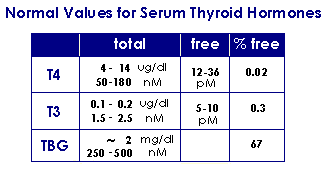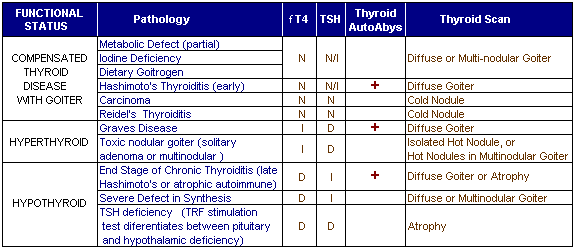Review of Normal Physiology
The thyroid gland elaborates two similar hormones, triiodo-thyronine (T3) and thyroxin (T4) having a variety of specific effects, the net result of which is increased basal metabolic rate. Thyroxin is by far the more quantitatively significant, but only T3 has biologic activity. Almost all T3 is produced extrathyroidally from deiodination of circulating T4.
 Both hormones are tightly bound by a serum transport protein, thyroxin binding globulin (TBG), synthesized by the liver, present at a molar concentration about three times greater than T4 and with one binding site per protein molecule. The affinity of TBG for T4 is considerably greater than the affinity for T3 so that a greater fraction of total T3 is free, or unbound, compared to the fraction of T4 which is free. Only the free portion of T3 is physiologically active and only the free portion of T4 is converted to T3.
Both hormones are tightly bound by a serum transport protein, thyroxin binding globulin (TBG), synthesized by the liver, present at a molar concentration about three times greater than T4 and with one binding site per protein molecule. The affinity of TBG for T4 is considerably greater than the affinity for T3 so that a greater fraction of total T3 is free, or unbound, compared to the fraction of T4 which is free. Only the free portion of T3 is physiologically active and only the free portion of T4 is converted to T3.
 Elaboration of thyroid hormones is stimulated by thyroid stimulating hormone (TSH) from the anterior pituitary which, in turn, is stimulated by thyrotropin releasing factor (TRF) from the hypothalmus. Normal levels of thyroid hormones are maintained by a negative feedback effect on the pituitary. TRF is necessary for TSH secretion to be stimulated by low circulating concentrations of free thyroid hormones.
Elaboration of thyroid hormones is stimulated by thyroid stimulating hormone (TSH) from the anterior pituitary which, in turn, is stimulated by thyrotropin releasing factor (TRF) from the hypothalmus. Normal levels of thyroid hormones are maintained by a negative feedback effect on the pituitary. TRF is necessary for TSH secretion to be stimulated by low circulating concentrations of free thyroid hormones.
During times of physiologic stress, when higher than normal concentrations of thyroid hormones are required, TSH concentrations increase to stimulate the thyroid to secrete greater than normal amounts of hormone. The pituitary can secrete TSH at a rate at least ten times greater than normal, which results in maximally stimulating the thyroid to secrete thyroid hormones about ten times greater than normal. In other words, the thyroid gland has about a 10-fold reserve capacity.
Laboratory Tests
(Click on a test for more details)
| Thyroid Stimulating Hormone (TSH)
Free Thyroxin (fT4)
| Currently, free T4 and TSH are the front line tests for evaluating thyroid functional status. It has only been within the last several years that tests for determining free T4 have been recognized to be sufficiently reliable and that the TSH radioimmunoassy has become sufficiently sensitive for general, routine clinical use.
Earlier, TSH was useful primarily for documenting primary hypothyroidism, and was insufficiently sensitive for accurately determining low values to document hyperthyroidism as is the case currently. |
| Total Thyroxin by Radioimmunoassay (TT4)
T3 Resin Uptake (T3RU)
Free Thyroxin Index (FTI)
| Earlier, TT4 radioimmunoassy was the front line general thyroid function test. Unlike fT4, TT4 values do not accurately reflect thyroid status when TBG is abnormal. To overcome this dificulty, the T3RU test was also conducted. FTI was then calculated from TT4 and T3RU results as an estimate of fT4. |
| Total T3 by Radioimmunoassay (TT3)
| Earlier, TT3 radioimmunoassay was useful for documenting cases of hyperthyroidism with normal TT4 values.
|
| TRF Stimulation Test
| The TRF stimulation test is used to distinguish between pituitary or hypothalamic deficiency as the cause of secondary hypothyroidism. Earlier, the test was also used to diagnose borderline cases of hyperthyroidism. |
Thyroid Autoantibodies
- antimicrosomal
- antithyroglobulin
Thyroid autoantibodies are used to identify Graves disease, Hoshimoto's thyroiditis or primary autoimmune myxedema as the specific causes of hyperthyroidism, euthyroid goiter or hypothyroidism, respectively. | |
| Thyroid Scan
| Return to the top of the page |
Characteristic Laboratory Test Results in Thyroid Disease
Characteristic laboratory test results in thyroid disease are summarized in the table below. A discussion of results in each category may be displayed by clicking on a functional status or a pathologic condition.
SUMMARY OF TEST RESULTS IN THYROID DISEASE

Return to the top of the page
Last Updated: March 17, 2000.
 Both hormones are tightly bound by a serum transport protein, thyroxin binding globulin (TBG), synthesized by the liver, present at a molar concentration about three times greater than T4 and with one binding site per protein molecule. The affinity of TBG for T4 is considerably greater than the affinity for T3 so that a greater fraction of total T3 is free, or unbound, compared to the fraction of T4 which is free. Only the free portion of T3 is physiologically active and only the free portion of T4 is converted to T3.
Both hormones are tightly bound by a serum transport protein, thyroxin binding globulin (TBG), synthesized by the liver, present at a molar concentration about three times greater than T4 and with one binding site per protein molecule. The affinity of TBG for T4 is considerably greater than the affinity for T3 so that a greater fraction of total T3 is free, or unbound, compared to the fraction of T4 which is free. Only the free portion of T3 is physiologically active and only the free portion of T4 is converted to T3. Elaboration of thyroid hormones is stimulated by thyroid stimulating hormone (TSH) from the anterior pituitary which, in turn, is stimulated by thyrotropin releasing factor (TRF) from the hypothalmus. Normal levels of thyroid hormones are maintained by a negative feedback effect on the pituitary. TRF is necessary for TSH secretion to be stimulated by low circulating concentrations of free thyroid hormones.
Elaboration of thyroid hormones is stimulated by thyroid stimulating hormone (TSH) from the anterior pituitary which, in turn, is stimulated by thyrotropin releasing factor (TRF) from the hypothalmus. Normal levels of thyroid hormones are maintained by a negative feedback effect on the pituitary. TRF is necessary for TSH secretion to be stimulated by low circulating concentrations of free thyroid hormones.
